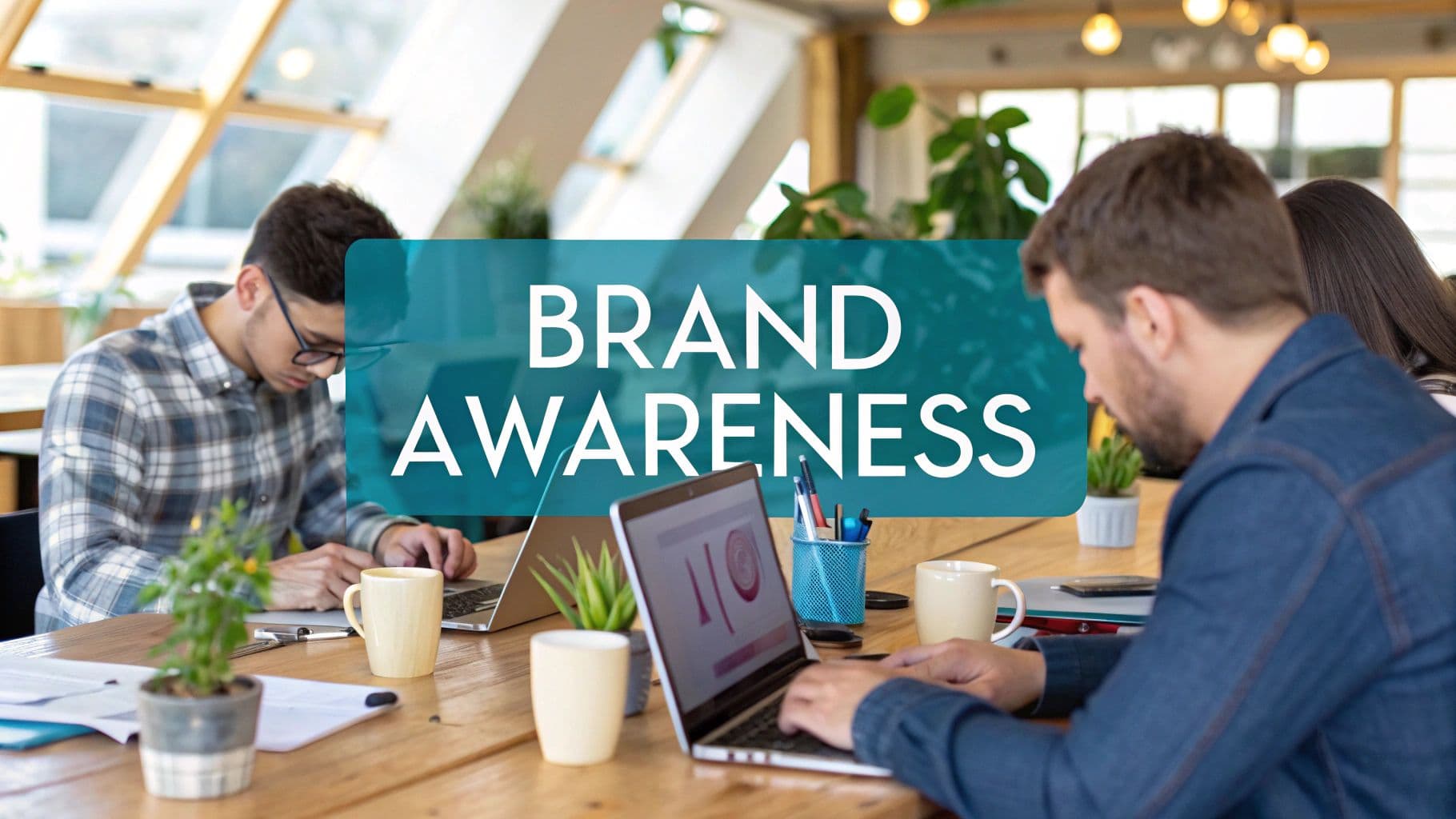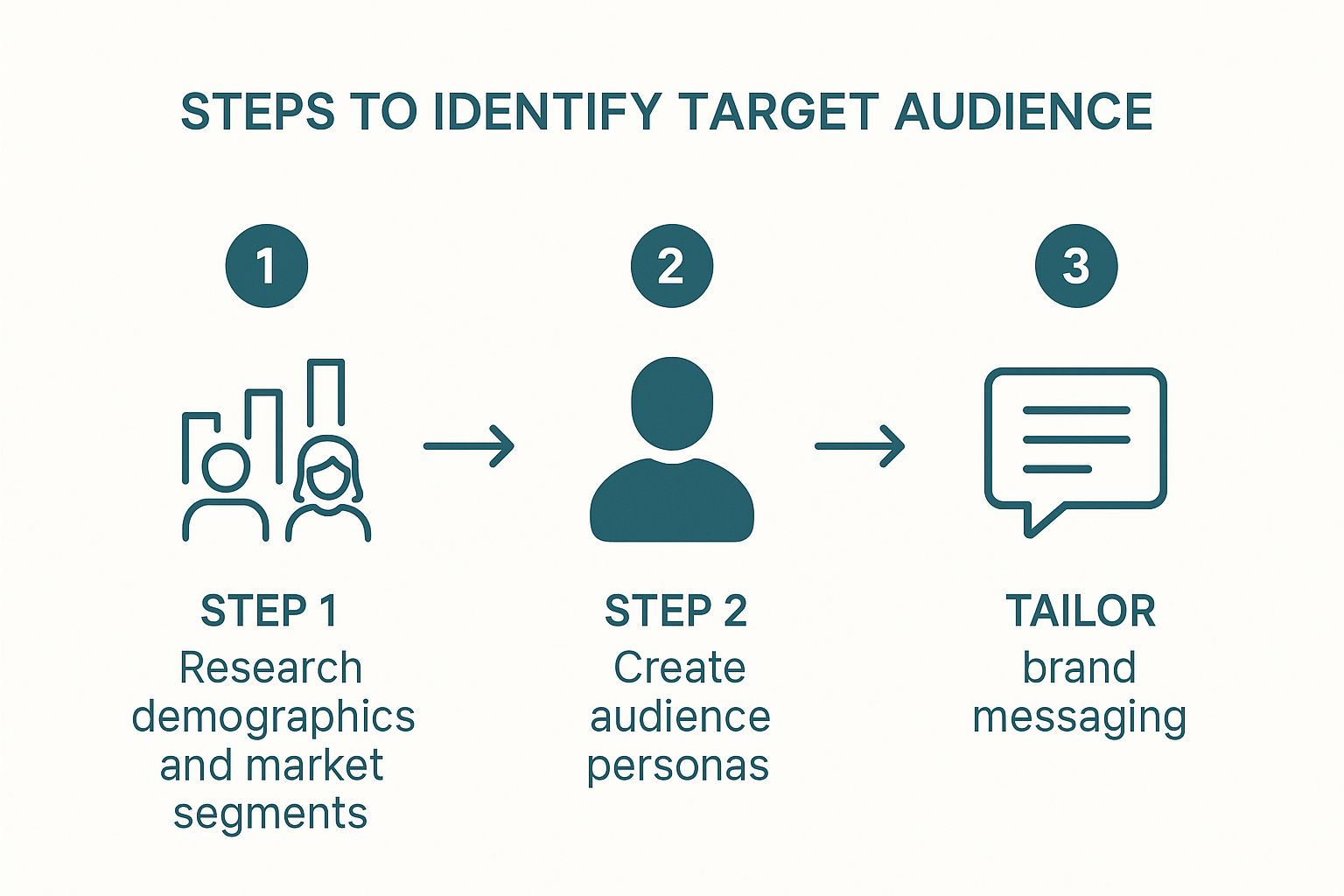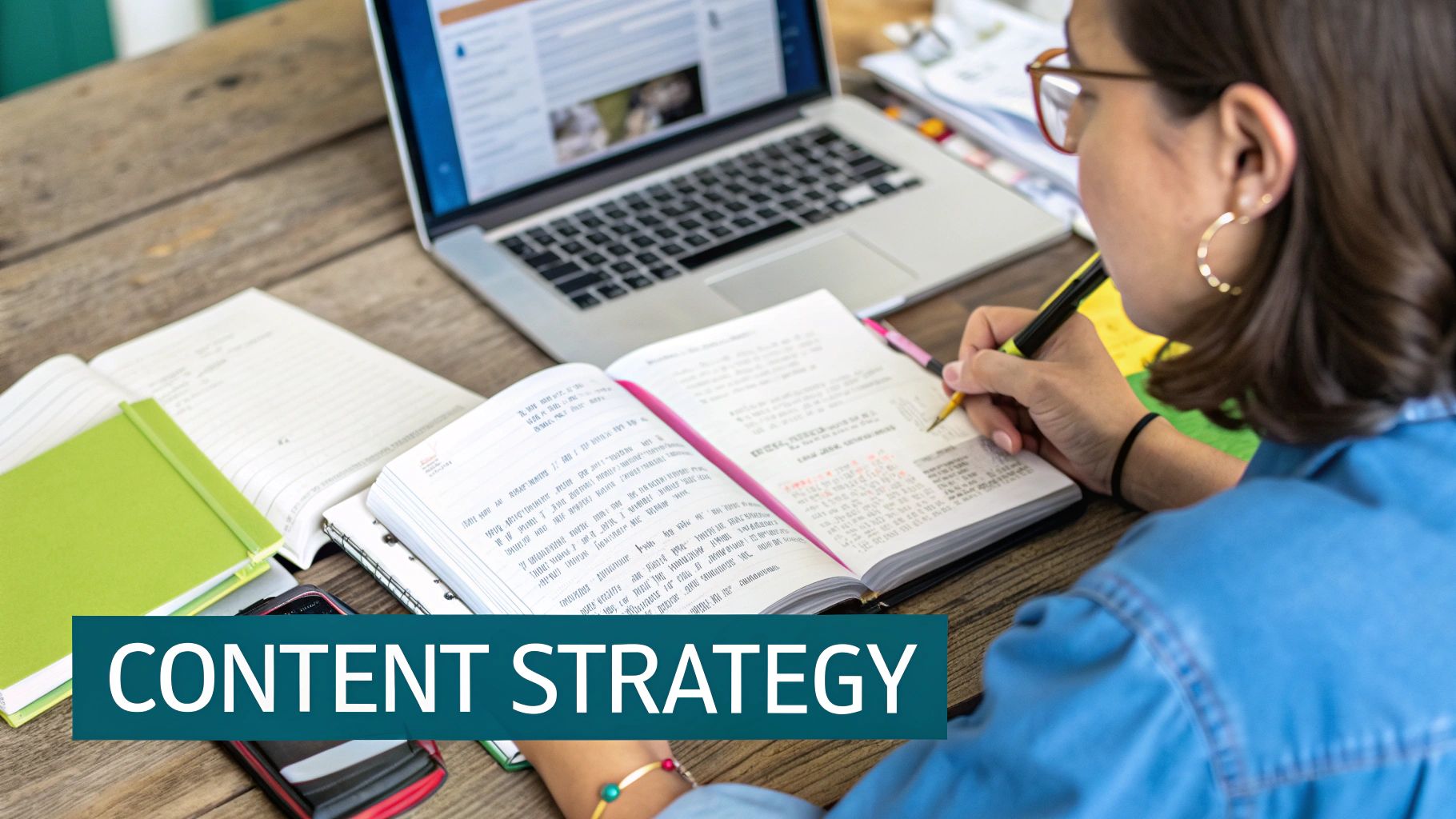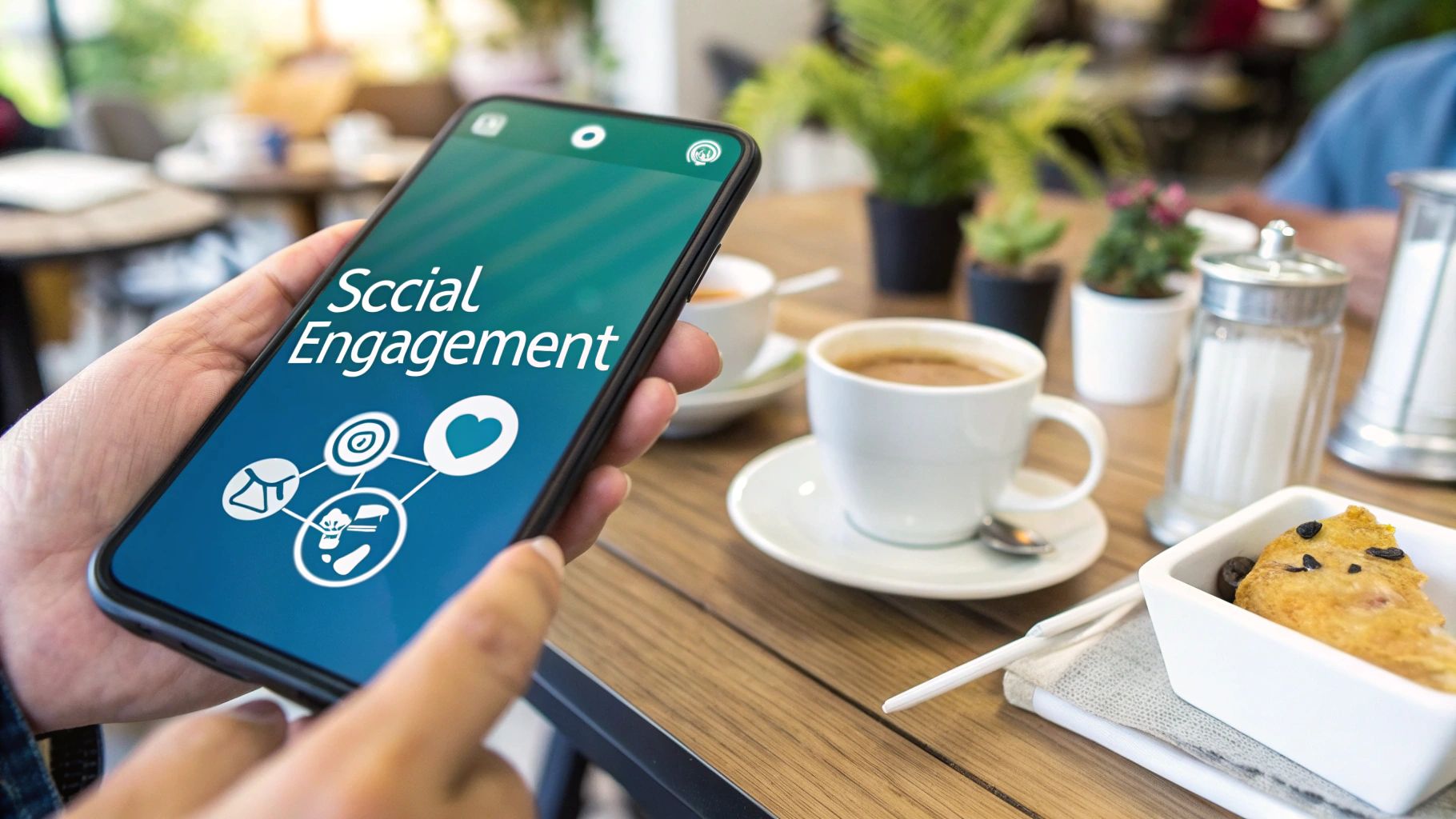
Building brand awareness isn't about chasing viral moments or throwing money at ads. It's about building a system. A playbook. It’s about being relentlessly helpful in the right places, consistently. This is how we stay top-of-mind with the founders who are our ideal customers.
Moving Beyond Vague Brand Awareness Advice
As founders, we've all heard the same advice: "be authentic," "create great content." It’s not wrong, but it’s completely unhelpful without a concrete plan. Platitudes don't build businesses; repeatable systems do.
This guide is the exact playbook we use at BillyBuzz. The secret isn't a massive budget; it's being smart, disciplined, and relentless in our execution.
We're moving away from the "if you build it, they will come" mindset. Instead, we're engineering a recognition engine. For a modern startup, brand awareness isn't just about getting impressions. It's about earning trust and recall, which requires a focused strategy, not a scattergun approach across every social media platform.
What Real Brand Awareness Looks Like
Before we jump into the tactics, let's get crystal clear on the goal.
Effective brand awareness means becoming the go-to answer for a specific group of people. It’s the difference between someone seeing your logo and someone thinking of your name when they have a problem you solve.
At BillyBuzz, we know we've achieved awareness when another founder recommends us in a private Slack channel or a subreddit before we even see the conversation. That's the endgame: turning passive observers into active advocates.
This process hinges on building trust. A foundational study found that a staggering 81% of consumers need to trust a brand before they'll even consider buying from it.
What’s more, 65% of consumers from that same research said a brand’s leadership and employees influence their purchasing decisions. Transparency isn't optional.
Building a Practical Framework
So, how do you actually do this? It starts by figuring out which metrics signal real progress and which are just vanity stats.
We'll lay out the KPIs that matter before diving into the specific tactics we use to drive growth. This guide is about giving you the tools, not just the theory. To really get started, you need to move beyond generic tips and explore actionable methods for enhancing your brand's presence. Checking out these top strategies to improve brand awareness and boost visibility is a great next step.
Building the Unsexy but Essential Brand Foundation
It’s tempting to jump straight into ads or outreach, but that’s putting the cart before the horse. Before you spend a dollar, you need a brand worth remembering. This is the unsexy, foundational work many founders skip, but getting it right makes every marketing effort that follows infinitely more effective.

This isn’t just about a cool logo. It’s about a cohesive identity so that every impression—from a LinkedIn comment to a sales deck—builds on the last. When you're consistent, you prime your audience to recognize you after just a few interactions.
Nail Your Positioning First
Your first job is to define who you are and, just as importantly, who you are not. If you try to appeal to everyone, you’ll appeal to no one.
At BillyBuzz, for example, we don’t just say we’re a "social monitoring tool." That's too broad. Our positioning is: "The AI-powered Reddit monitoring tool for early-stage founders who need to find their first customers without a big budget."
That statement dictates everything:
- Who we target: Early-stage founders, not enterprise marketing teams.
- What we highlight: The direct benefit of finding customers, not just "brand mentions."
- Our key differentiator: Affordability and efficiency, not a hundred complex features.
Having this clarity stops us from wasting time and money. It’s our north star.
Develop a Cohesive Visual Identity
Once you know who you are, you need to look the part. Your visual identity is the cognitive shortcut that helps people recognize you in a split second. Research shows that a brand’s signature color can boost recognition by up to 80%.
In fact, consumers are reportedly 81% more likely to recall a brand’s color than its name, and an incredible 90% of snap judgments about products are based on color alone. You can read more about these branding statistics to really see how crucial visual consistency is.
Your visual brand isn't just a logo. It's the combination of colors, fonts, and imagery that creates a predictable, professional experience everywhere you show up. Repetition builds recognition.
To make this simple, we created a one-page brand guide. It’s not some 100-page document nobody reads; it's a practical tool we use daily.
Our Internal Brand Consistency Checklist
Discipline separates memorable brands from forgettable ones. We live by a simple checklist to ensure every asset is on-brand. This isn’t about being rigid; it’s about being instantly recognizable.
Here’s what we check before anything goes public:
- Primary Logo Usage: Is the correct logo version used? Is there proper clear space? No stretching, squashing, or slapping it on a busy background.
- Color Palette: Are we sticking to our primary and secondary colors? We strictly limit designs to our brand palette (
#4A90E2blue,#F5A623orange, and our neutral grays). No exceptions. - Typography: Is the headline font (Montserrat Bold) and body font (Lato) correct? Consistent typography makes our content feel familiar and easier to read.
- Imagery Style: Does the image or graphic feel like us? We aim for clean product screenshots and photos with a consistent, slightly desaturated filter.
- Tone of Voice: Does the copy sound like us? Direct, helpful, founder-to-founder, and free of corporate jargon.
This checklist applies to everything—our website, social banners, presentations, and email signatures. It's a non-negotiable part of our workflow. This is how marketing efforts become cumulative, not fragmented.
Winning Attention in Niche Communities like Reddit
Forget trying to shout over the noise on massive social platforms. Your ideal customers are already in niche communities, talking about the very problems your product solves. For us at BillyBuzz, that goldmine is Reddit.
This isn't just one strategy; it's our core playbook for building brand awareness from scratch.
The key is to act like a valued community member first and a marketer second. Redditors have a finely tuned radar for self-promotion. Drop a link and run, and you'll get downvoted. But if you show up to genuinely help, you build trust that turns lurkers into advocates.
Before you engage, you need to know who you're talking to. The flowchart below shows how we map our audience before we write a single comment.

As you can see, crafting the right message is the final piece, not the starting point. It’s built on a solid foundation of audience research.
Finding Your Subreddit Goldmines
First, find where your people are. This isn't about targeting the biggest subreddits; it's about finding the most relevant ones. We use a combination of Reddit searches and our own tool, BillyBuzz, to map the landscape.
Inside BillyBuzz, we set up alert rules that cast a wide net, focusing on three categories:
- Problem-Aware Keywords: "customer feedback," "finding users," "market research," "validate my idea."
- Competitor Keywords: We track our direct and indirect competitors to see where users are discussing their strengths and weaknesses.
- Solution-Aware Keywords: "social listening tool," "Reddit monitoring," "brand mentions."
This finds relevant conversations where we can add value, even if our brand isn't mentioned.
How We Filter for High-Value Subreddits
Not every community is worth your time. Here are the actual subreddits we actively engage in and why:
- r/startups: Packed with our target audience asking for direct advice on getting their first users. The ultimate hunting ground.
- r/SaaS: Conversations are more advanced, focused on growth tactics and metrics. A great place to establish authority.
- r/EntrepreneurRideAlong: Founders document their journeys in real-time. Engaging here lets us offer targeted advice at crucial moments.
- r/marketing: Broader, but great for connecting with marketers at smaller companies looking for new growth channels.
We prioritize subreddits where the top posts are questions, not just links or memes. A community built on Q&A is a community ripe for a value-first engagement strategy. This simple rule has saved us hundreds of hours.
Our Internal Reddit Engagement Playbook
We treat Reddit engagement like a structured campaign. Here's our exact process:
| Phase | Action | Tool or Method We Use | Our Key Objective |
|---|---|---|---|
| Discovery | Monitor keyword alerts for problems, competitors, and solutions. | BillyBuzz alert rules sent to a dedicated Slack channel (#reddit-mentions). |
Identify high-intent conversations where we can genuinely help. |
| Qualification | Review the post and comments to understand the user's specific pain point. | Manual review of user history and thread context. | Ensure our advice is relevant and not a generic plug. |
| Engagement | Write a comment that offers direct, actionable advice. | Our internal response templates (see below). | Provide a complete solution within the comment itself. |
| Follow-Up | Check back on the thread to answer follow-up questions. | Native Reddit notifications. | Build a relationship and show we're invested in their success. |
This systematic approach ensures we're consistently adding value and building a positive reputation.
Crafting Comments That Actually Build Your Brand
Your response is everything. Our guiding principle is simple: give 90% value, 10% mention. Your comment needs to be helpful on its own.
Here's an actual response template we use when someone asks for advice on finding their first customers:
Hey, finding those first 10 users is a grind. A tactic that worked for us was manually monitoring a few key subreddits where our ideal customers hang out. We just looked for posts where people were complaining about [Problem X] and offered helpful, no-strings-attached advice.
It's time-consuming, but the feedback is pure gold. For instance, we found a thread in r/SaaS where someone was frustrated with complex enterprise listening tools. We jumped in, shared a few tips on getting started without a big budget, and built a great relationship.
If you want to scale that process, you could use a tool to automate the monitoring (full disclosure, that's what my tool BillyBuzz does). But honestly, you can start today with 30 minutes of manual reading and responding. The key is to be helpful, not promotional.
This approach works because it provides a genuine strategy first. Our tool is mentioned only as an optional way to scale the process. That’s the core of our strategy. For more inspiration, check out these examples of effective Reddit AMAs to see this strategy in action.
Creating and Distributing Content That Works for You
Content is the engine of brand awareness, but so many founders fall into the trap of constantly chasing the next piece. It's a recipe for burnout. At BillyBuzz, we stopped creating more content and started creating smarter content. Our approach centers on “leverage assets”—one significant, pillar piece that works for us for months.

This isn’t about pumping out content to fill a calendar; it’s about strategic presence. We focus on one deep, tactical guide and then break it down to fit everywhere else. That single asset becomes the source material for everything, making our message consistent and multiplying our efforts without draining our resources.
The Power of Atomizing Content
This process of breaking down a large piece of content is called "atomization." You're taking a comprehensive guide and slicing it into smaller, native formats for different platforms. This is the secret to creating the feeling of being everywhere without producing new material from scratch daily.
Let’s say we write a 3,000-word blog post on finding your first customers on Reddit. Here's how we systematically repurpose it:
- LinkedIn Carousel: We'll pull out five key takeaways, design them as clean slides, and write a short caption pointing back to the full article.
- Twitter Thread: The main sections of the guide become individual tweets in a thread. The final tweet links back to the original post.
- Short-Form Video: We’ll script a 60-second video that summarizes the single most actionable tip from the article for Reels, Shorts, and TikTok.
- Newsletter Content: The guide’s introduction and key points become the heart of our weekly newsletter, delivering value directly to our subscribers' inboxes.
See the pattern? We’re not just spamming links. We're delivering value in the specific format each platform's audience prefers, all from a single source of truth.
Executing Our Surround Sound Strategy
This atomization fuels our "Surround Sound" strategy. The goal is to make our brand ubiquitous to our target customer in a short window of time. Imagine a potential customer sees our tweet in the morning, a LinkedIn post that afternoon, and then gets our newsletter—all reinforcing the same message. That’s how you build recognition and authority, fast.
It creates momentum. Instead of seeing disconnected posts, your audience gets a cohesive story. Each piece builds on the last, solidifying your brand as the go-to expert.
The magic of the Surround Sound strategy isn’t just about being seen; it’s about being remembered. When every channel echoes the same core value proposition, your brand becomes impossible to ignore for the right audience.
Weaving in Authentic Social Proof
Of course, our own content can only take us so far. We actively mix customer stories and user-generated content (UGC) into our strategy. This adds authenticity that is far more powerful than anything we could write ourselves.
The data backs this up. Consumers find user-generated content 50% more trustworthy and 20% more influential than traditional ads. The importance of social proof is hard to overstate.
To find these opportunities, we monitor mentions of our brand and industry. This lets us amplify positive customer experiences and turn happy users into our most effective marketers. For a closer look at how we do this, you can check out our guide on 10 ways to enhance your social media monitoring efforts.
By combining a single pillar content piece with a strategic distribution plan and social proof, we create a system for building brand awareness that's both scalable and efficient. It stops being about outspending the competition and starts being about out-thinking them.
Use Partnerships to Jumpstart Your Reach
Building an audience from scratch is a slow grind. As a founder, your most precious resource is time. Why build your audience one person at a time when you can tap into an existing one?
Partnering with others who have already built the audience you want is the fastest way to get your brand noticed.

This isn't about paid promotions. This is about building real relationships with other founders and marketers who serve the exact same customer you do. When you get this right, you create a powerful growth engine that drives continuous, organic cross-promotion without a huge budget.
How to Find the Right Partners
The magic happens when you find a non-competing brand with massive audience overlap. You're looking for companies that solve a different problem for the same person.
At BillyBuzz, our ideal customer is an early-stage founder trying to find their first users. We mapped out their entire journey. What tools are they using before and after they find product-market fit?
This simple exercise gave us a treasure map of potential partners:
- Pre-PMF Tools: Landing page builders, survey tools, design software.
- Post-PMF Tools: CRMs, email marketing platforms, analytics tools.
A founder using a landing page builder is the perfect person who needs our tool to find customer conversations on Reddit. The audiences align perfectly, but our products don't compete. It's a win-win.
Crafting a Pitch That Actually Gets a Response
When you reach out, it has to be founder-to-founder. Direct and focused on mutual value. Anything that looks like a corporate, templated email gets deleted.
I've found the best way in is by pitching a specific, low-effort idea first. This builds trust and opens the door for bigger things later.
Here’s a simple outreach email that works for us:
Subject: Collab Idea? BillyBuzz + [Partner Company]
Hey [Founder Name],
Big fan of what you're building at [Partner Company]. I’ve been following your progress and love how you’re helping founders solve [Problem X].
I run BillyBuzz, and we help founders find their first customers by monitoring Reddit. There’s a huge overlap in our audiences, and I had a quick idea for a co-marketing win.
How would you feel about a simple content swap? We could write a short, practical section for your next newsletter on "3 Ways to Validate Your Idea on Reddit," and we'd love to feature a piece from you for our audience.
No major commitment—just a simple way to deliver value to both our communities.
Let me know if you're open to it.
Cheers,
[Your Name]
This works because it’s specific, doesn't ask for much, and shows you've done your homework. It’s a small “yes” that paves the way for bigger opportunities.
Turning Small Swaps Into Big Wins
Once that connection is made, you can explore more involved projects. The goal is to create a flywheel of mutual promotion that constantly builds awareness for both brands.
Our partnership funnel usually progresses like this:
- The Icebreaker: A low-effort content swap or a social media cross-promotion.
- Working Together: Co-authoring a blog post or a joint guide.
- Going Live: Hosting a joint webinar or a live Q&A session.
- Product Synergy: Looking for simple ways the products can work together or integrate.
By starting small and proving you can deliver value, you build the trust needed for more impactful collaborations. This founder-led approach has been one of our most effective strategies for building brand awareness without a big ad spend.
How We Measure Brand Awareness That Actually Matters
Putting effort into building your brand is pointless if you can’t tell what’s working. Brand awareness can seem fuzzy, but there are concrete metrics you can track that show real progress. As founders, we have to push past feel-good numbers like impressions and focus on what shows our brand is sticking in people's minds.
This is about building a data-backed strategy, not running on gut feelings. At BillyBuzz, we concentrate on a handful of key indicators that tell us if our work in communities like Reddit or on platforms like LinkedIn is turning into real recognition.
Moving Beyond Vanity Metrics
First, we ignore metrics that don't tie back to business goals. A huge impression count or a spike in followers is a nice ego boost, but it doesn't mean your brand is memorable to potential customers.
Instead, we track the leading indicators of genuine awareness.
Our primary metrics boil down to three categories:
- Direct & Branded Traffic: Are people coming straight to our website by typing our URL or searching for "BillyBuzz"? This is a huge signal they remember our name.
- Social & Community Mentions: We look for untagged conversations where people are talking about us or the problems we solve. That’s where the real sentiment is.
- Share of Voice: In relevant online discussions, how often is our brand mentioned compared to our competitors? This tells us if we’re owning a piece of the conversation.
If you want to get a handle on your brand's standing in the market, digging into share of voice is a great place to start. For a deeper dive, check out A Practical Guide to Share of Voice Measurement.
Our Simplified Awareness Dashboard
We don't use a complicated, overwhelming dashboard. We track a few core numbers weekly to keep a finger on the pulse. This keeps us from getting lost in the noise and helps us make quick calls on what’s working.
A simplified version of what we look at internally:
| Metric | Tool We Use | What It Tells Us |
|---|---|---|
| Direct Website Traffic | Google Analytics | Measures how many people know us well enough to skip search engines. |
| Branded Search Volume | Google Search Console | Shows growth in people actively looking for our brand name. |
| Untagged Mentions | BillyBuzz | Uncovers organic conversations happening about us without any prompting. |
For us, the single most valuable metric is the growth in untagged mentions within niche subreddits. When someone recommends BillyBuzz without us being in the conversation, we know our brand-building efforts are creating true advocates.
Keeping an eye on these indicators gives us the confidence to know which strategies are driving real brand awareness. It also gives us a read on the emotional response people have to our brand. Understanding the sentiment behind these mentions is critical, and we've put together a guide on how AI improves brand sentiment benchmarking that goes deeper on this. It ensures we're not just building a brand people recognize, but one they genuinely trust.
Founder FAQs on Building Brand Awareness
As founders, we constantly get asked how to build a brand from scratch. Here’s the real talk based on our own experience getting BillyBuzz off the ground.
What’s a Realistic Budget for an Early-Stage Startup?
Forget a dollar amount. Your initial budget is your time.
Seriously, the best thing you can do early on is focus on "sweat equity"—tactics that demand your effort, not your cash. We personally committed 5-10 hours every week to engaging in Reddit communities and creating content on our personal LinkedIn profiles. That was our marketing budget.
Don't let paid ads cross your mind until you've proven your messaging works and you're seeing signs of product-market fit. Your first investment should be in learning from your audience and building real relationships.
How Long Until I See Real Results?
Building a brand is a marathon. If you’re consistent, you can start seeing early signs within 90 days. This might be an uptick in direct traffic or hearing people say they “see you everywhere.”
But for that buzz to turn into measurable leads and sign-ups, you need to commit to at least 6-12 months of consistent effort. A post here and there won't cut it. You have to show up regularly to build the momentum required for people to remember you. Consistency is non-negotiable.
What's the Single Biggest Mistake Founders Make?
Hands down, trying to be everywhere at once. It's a classic founder trap. You get excited, create profiles on ten different platforms, and end up doing a mediocre job on all of them because you're spread too thin.
The smarter approach? Find the one channel where your ideal customers are most active and engaged. For us, it was a handful of specific subreddits. We went all-in to own that space.
Go deep before you go wide. Once you have a repeatable playbook that's working, then you can start expanding to another channel.
Ready to stop guessing and start finding customers where they’re already talking? BillyBuzz uses AI to monitor Reddit for high-intent conversations, letting you join in at the perfect moment to build your brand authentically. Learn more and start your free trial.
